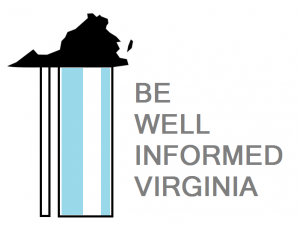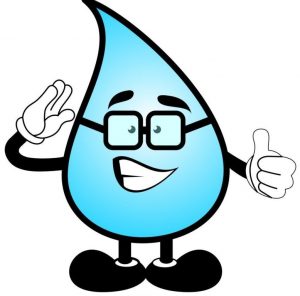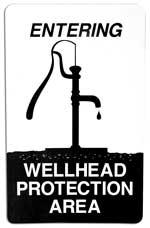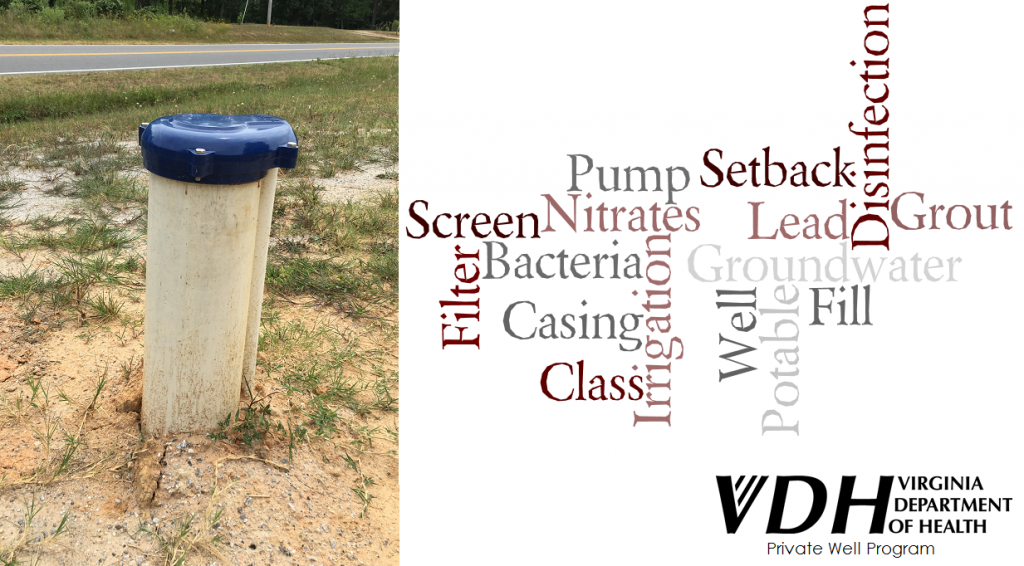

Use the links below for detailed information
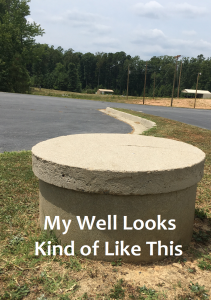
Learn More About Bored Wells You have a BORED Well (or, possibly, a HAND DUG Well) Bored wells are generally shallow (<100 foot deep) wells that obtain water from near surface unconfined or "water table" aquifers. The well is typically constructed by using a bucket type rig to dig a 30" diameter hole into the earth, generally between 45 and 70 feet in depth. Concrete well casing diameter is then lowered into the well in three to five foot long sections which fit together in a tongue and groove fashion and line the well from bottom to top. The tongue and groove connections are not water-tight and allow groundwater to enter the well. The area around the outside of the casing is then back- filled to at least 20 feet below the ground surface. Once this is done, cement grout is pumped around the outside of the casing from ground level down to 20 feet to prevent surface water or contaminants from entering the well. In addition, a layer of fine gravel is poured into the bottom of the well in order to prevent the water from become cloudy during heavy pumping cycles. This type well is generally less expensive than the drilled type well; however, it can be more susceptible to contamination from activities at the surface. |
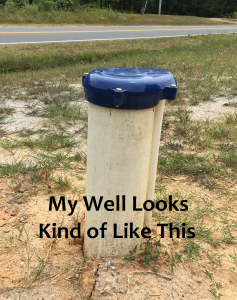
Learn More about Drilled Wells You have a DRILLED Well Drilled wells can be shallow or deep, and may obtain water from unconfined, or confined aquifers, including aquifers found in fractures in bedrock. The well is typically constructed with machines for rotary or percussion drilling. Drilled wells need to be installed with casing, typically either steel or plastic. This is to avoid the collapse and influx of sediments and other particles. Once the desired water horizon is reached, a well screen - defined as a section of casing having apertures allowing passage of water into the well - is placed. A filter pack (typically sand) is placed outside the screen to filter groundwater entering the well. Once this is done, cement grout is pumped around the outside of the casing from the top of the filter pack to the ground surface to prevent surface water or contaminants from entering the well. Generally, drilled wells are less susceptible to contamination from activities at the surface, and can access more sources of groundwater than can bored wells. |
I'd Like To Watch a Video about Wells
What is the Relationship Between Where I Live and My Well?
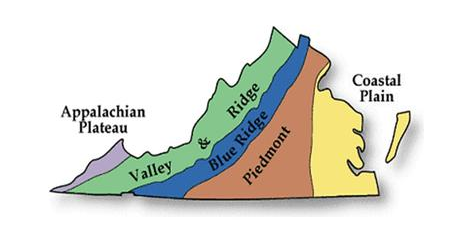
There is a significant relationship because groundwater in Virginia occurs under a variety of conditions.
If you live in the COASTAL PLAIN (generally found east of Interstate 95), then the land beneath you consists of multiple layers of unconsolidated sediments (clays, silts, sands, and gravels) which grow thicker as you move towards the Atlantic Ocean. Your well is obtaining water from one of these layers of sediments. If it is shallow, your well is most likely tapping the unconfined aquifer. Deeper in the Coastal Plain are found various confined aquifers, separated by relatively impermeable formations of clay rich materials which act as barriers to vertical groundwater movement. If you have a deep well, it is obtaining groundwater from one of these confined sources.
If you live in the PIEDMONT (between Interstate 95 and the Blue Ridge Mountains), then the land beneath you consists of a veneer of soil and thin sediment above igneous or metamorphic bedrock (although there are some areas where sedimentary rock occurs over igneous/metamorphic bedrock). Your well could be obtaining water from near surface sediments, weathered bedrock, or fractures within the bedrock itself.
If you live in the BLUE RIDGE MOUNTAINS, then the land beneath you is primarily hard volcanic rock. Your well could be obtaining water from near surface sediments, weathered bedrock, or fractures within the bedrock itself.
If you live in the VALLEY AND RIDGE, then the land beneath you consists of a veneer of soil and sediment above sedimentary rocks such as sandstone, limestone, dolomite and shale. Your well could be obtaining water from near surface sediments, weathered bedrock, or fractures within the bedrock itself. In Karst areas (where limestone is dissolved and caves are prevalent), your well might be at elevated risk of contamination because water from the surface can enter karst bedrock and become part of shallow aquifers more readily than in non-karst areas.
If you live in the APPALACHIAN PLATEAU, then the land beneath you consists of a veneer of soil and sediment above non-carbonate sedimentary rocks such as sandstone, shale, and coal. Your well could be obtaining water from near surface sediments, weathered bedrock, or fractures within the bedrock itself.
A Historical Perspective
The First Public Health Protection Rule in America
"There shall be no man or woman, Launderer or Launderesse, dare to wash any uncleane Linnen, drive bucks, or throw out the water or suds of fowle cloathes, in the open streete, within the Pallizadoes, or within forty foote of the same, nor rench, and make cleane, any kettle, pot or pan, or such like vessel within twenty foote of the olde well, or new pumpe."1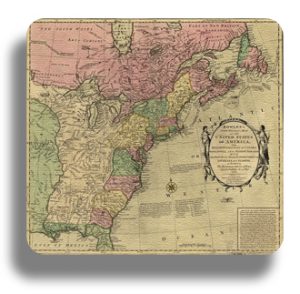
The year was 1610. This was over 400 years ago! The rule was made by the Military Governor at Jamestown where early settlers had set up a military fort. Their rule was made because of the need to protect the quality of the well water. We knew all those years ago that the best way to protect drinking water is to keep contamination away from the well.
The same is just as true today as it was then.
1"Articles, Lawes, and Orders, Divine, Politique, and Martiall for the Colony of Virginia." in Peter Force, ed. Tracts and Other Papers, Relating Principally to the Origin, Settlement, and Progress of the Colonies in North America, From the Discovery of the Country to the Year 1776. 4 vols. (Washington, D.C.: 1836 reprint, Gloucester, Massachusetts: Peter Smith, 1963).III.9-19.
The most important things about private wells are location and construction. VDH can assist you, and the place to start is your LOCAL HEALTH DEPARTMENT, which you can find using this LINK. Just ask for Environmental Health. You will be asked to complete a Septic and Well application and submit an application fee. Again, this all happens at your LOCAL HEALTH DEPARTMENT.
You will need to rely on a private sector provider such as a well driller or onsite soil evaluator to conduct a sanitary survey of your property in order to locate your well in a safe place where it will be protected from contamination. Health Department personnel can provide this service for persons meeting Hardship Guidelines.
Once the sanitary survey is approved, you will be issued a private well Construction Permit. This document will be used by a licensed Water Well System Provider to install and construct your well. Following construction, LOCAL HEALTH DEPARTMENT personnel will inspect the well in order to approve it for use.
If you have a question about a specific well, well site, permit, or project, your LOCAL HEALTH DEPARTMENT is the place you can start.
Alternately, you can use VDH's Freedom of Information Act Tool
We can answer that question in two ways
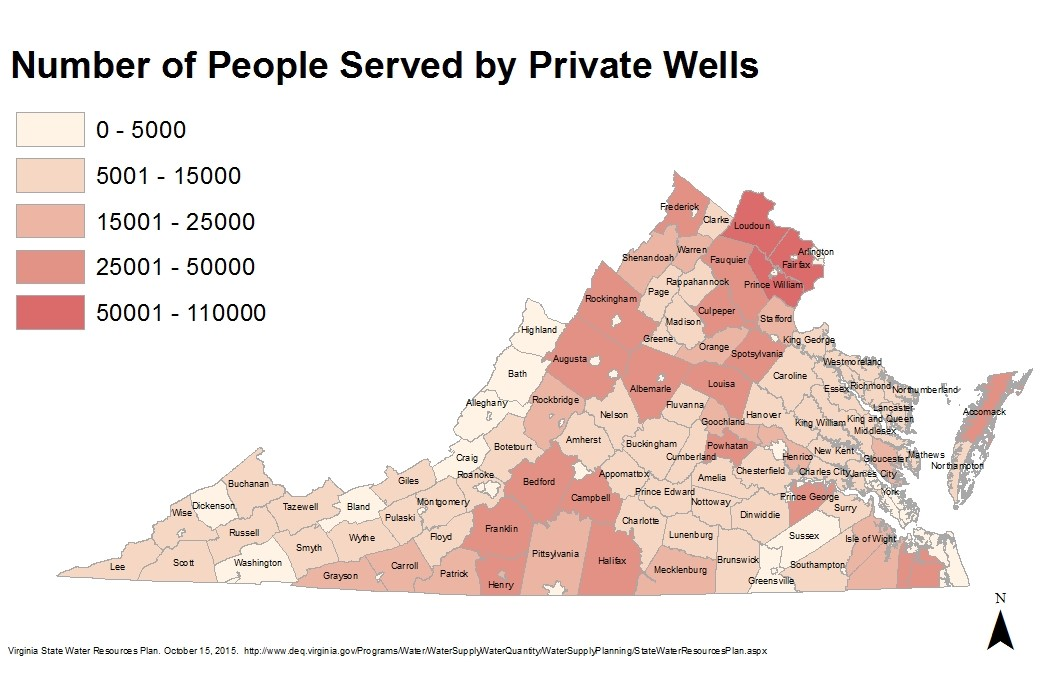
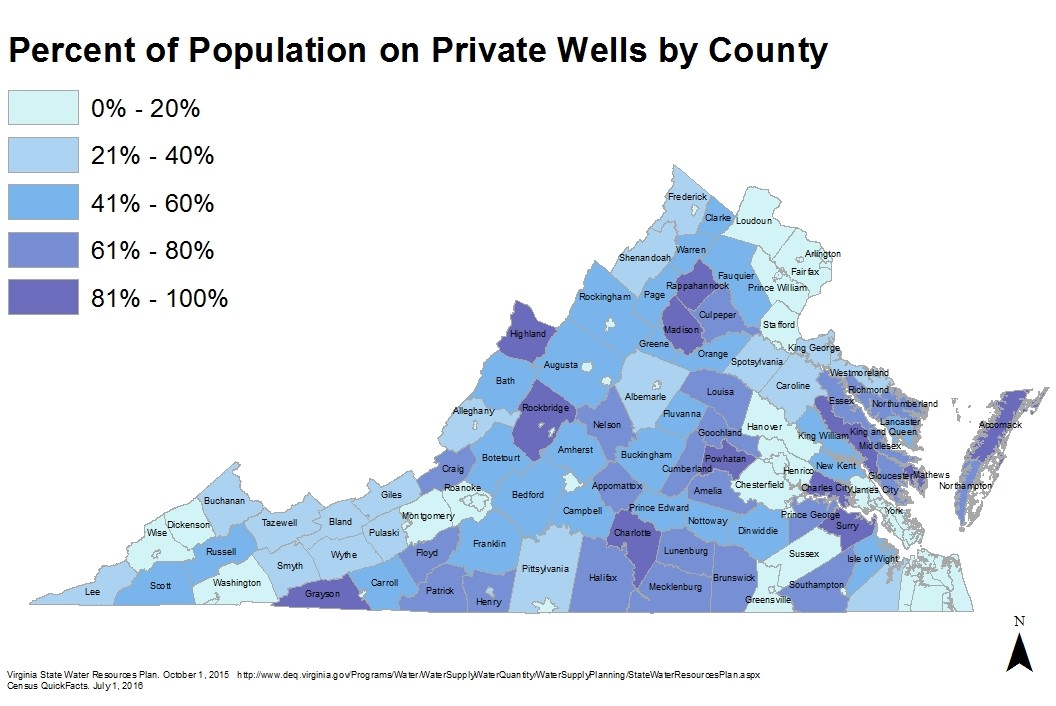
Buying or selling a house with a private well?Learn even more in our FAQS for Real Estate |
Will VDH test my well water?
No, VDH does not test private wells. All aspects of the operation and maintenance of private wells is the responsibility of, and at the discretion of, the well owner. VDH does not have authority to test private well quality or the authority to require others to test private well quality.
Test Your Well Water Because It's YOUR Health
P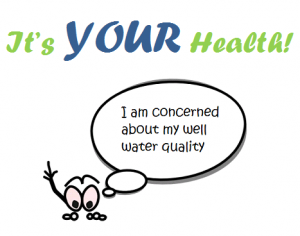 eople who obtain their drinking water from private wells and use onsite sewage treatment systems for their waste water disposal rely on truly local resources. Typically this results in great water; however, unlike public water supply system users, well owners rely on water that is not required by regulation to be tested regularly for contaminants and other water quality parameters.
eople who obtain their drinking water from private wells and use onsite sewage treatment systems for their waste water disposal rely on truly local resources. Typically this results in great water; however, unlike public water supply system users, well owners rely on water that is not required by regulation to be tested regularly for contaminants and other water quality parameters.
Virginia’s Private Well Regulations include requirements for the disinfection and bacteriological testing when the well is installed. From that point in time forward, the well owner has the responsibility to ensure that the water supply remains safe.
And it can be mighty confusing.
We’ve developed the “It’s YOUR Health” information program to help private system owners with the educational, emergency, and service provider information needed to safeguard wells and septic systems so that they remain protective of human health and the environment. Because it’s YOUR health!
Maybe it’s something about the taste. Maybe it just looks cloudy. Maybe you are wondering about that nearby gas station, onsite sewage treatment system, factory, or farm. There are many legitimate reasons to be concerned about your private well water quality. Luckily, there are answers.
Virginia’s Private Well Regulations (12VAC5-630) require testing of newly constructed wells for coliform organisms. This test does not cover all contaminants. After installation, all subsequent testing is entirely at the discretion of the well user. Water testing that is done in association with home purchases is not required by the VDH but may be required by the lender providing the mortgage.
Testing your well water is the best way to ensure that your drinking water supply is safe from harmful chemicals and bacteria. In addition, water testing can determine whether nuisance impurities such as iron and manganese are present. The purpose of this fact sheet is to assist you as a private well owner to decide how frequently to test your private well water and what to test it for. It also provides you with information about how to get your water tested, understanding your water test results and protecting your well from contamination. In addition to these guidelines, we encourage you to check with your Local Health Department to find out whether there are water quality problems specific to your area. It is also a good idea to ask your neighbors whether they have ever had water quality problems.
How Do Pollutants Get Into My Well Water?
Well water comes from rain and snow that soaks into the ground. As water seeps through the soil and rock, it can pick up pollutants and other materials that are present in or on the ground. Some contaminants that are commonly found in well water at unsafe levels come from the rocks and soil that the water flows through. The most common in Virginia are bacteria, radon, arsenic, iron, manganese, and radiological contaminants.
Other contaminants get into well water from human activities. Gasoline storage and spills, industrial/ commercial activities, improper waste disposal and road salting can introduce toxic substances to the ground. Even typical residential activities, such as using fertilizers or pesticides too close to a well, spilling fuel and improperly disposing of household chemicals can contaminate well water.
Some constituents of concern – arsenic for example – can be naturally occurring as well as introduced from human activities.
What Should I Test For, and How Often Should I Test?
Newly constructed private wells in Virginia are required to be tested for bacteria as a condition for use. While not required, and regardless of whether the well is existing or brand new, VDH suggests that prospective homebuyers test private well water for basic indicators, bacteriological and radiological chemicals of concern (see below).
Water quality in wells tends to be stable, and if change occurs, it typically happens slowly. For this reason, once baseline water quality is established, several years can pass before the need for retesting of wells that are properly constructed and safely located. Bacteria and nitrate are the exceptions, and annual testing is recommended.
Private well users should always consider additional testing if a wellhead is flooded, or if there is a noticeable change in quality, taste or appearance or any other unexplained change in a previously trouble-free well.
Even if you do not suspect any well water problems, it is important to test your water to ensure that it is safe to drink. The following table lists the tests VDH recommends for all private wells even if you do not notice any problems with your water.
Basic Indicators (Potability)
The basic indicator list covers the most common potential contaminants associated with private wells. Some of these contaminants present health-related concerns; others affect aesthetics (taste, staining, odor). The recommended tests are alkalinity, arsenic, cadmium, chromium, bacteria, chloride, copper, fluoride, hardness, iron, lead, manganese, mercury, nitrite/nitrate, pH, sodium, sulfate, total dissolved solids, and turbidity.
Bacteriological
Bacteria in well water can lead to gastrointestinal illness. The recommended tests include total coliform and e-coli.
Radiological
The rocks in Virginia contain naturally occurring radioactive elements that dissolve in groundwater. The recommended radiological analysis will test for uranium, gross alpha and radon.
ADDITIONAL TESTS TO CONSIDER
Testing for the following potential contaminants should be considered when circumstances specific to your property suggest reason for concern. VDH does not recommend routine testing for petroleum products, herbicide, pesticides or other chemicals of concern.
Petroleum Constituents
Testing for petroleum constituents may be warranted if you know or suspect nearby petroleum storage, use, or release, including home heating oil tanks; or if there is an odor or taste of petroleum in your well water. The recommended baseline petroleum constituent analysis will test for benzene, toluene, ethylbenzene, total xylenes, naphthalene, and MTBE.
Herbicides/Pesticides
Testing for herbicides and pesticides may be warranted if (a) your well is located closer than 50 feet from a building foundation that was treated for termites prior to 1990, (b) significant amounts of herbicides or pesticides have been applied near your well, or (c) if your well water is found to contain elevated nitrite or nitrate concentrations and an agricultural source is suspected. The recommended baseline herbicide/pesticide analysis will test for dieldrin and chlordane.
| Test | How Often | Purpose |
| Basic Indicators (Potability) | An initial test is suggested. If no problems, once every 5 years thereafter | The basic indicators provide you with a general indication of water quality, and are useful to determine if additional tests are warranted. |
| Lead | If your water is corrosive (pH <6), consider more frequent testing | Lead can leach from plumbing (pipes and faucets). Lead pipes may be in homes built before 1930. Lead-based solder may be in homes built before 1988. Brass is used in new plumbing and fixtures. All brass contains small amounts of lead. Corrosive water leaches more lead. Young children are more susceptible to harmful effects from lead exposure. |
| Nitrate | Annually | High levels of nitrates can cause health problems, including methemoglobinemia, commonly known as “blue baby syndrome.” |
| Bacteriological | Annually | The bacteriological tests provide you with protection against acute gastrointestinal illnesses. |
| Radiological | At least one time | The radiological tests identify effects of naturally occurring radioactive elements in rock and sediments. |
| Fluoride | Every 5 years when children under 5 are regular users | Fluoride can occur naturally in wells throughout Virginia. A child’s permanent teeth can become discolored from excess fluoride. Too little fluoride can increase risk of tooth decay. Your child’s dentist may ask you about the fluoride level in your well water. |
| Petroleum, Herbicide/Pesticide | If suggested by site conditions | Evaluation of site specific contaminant threat. |
There may be other potential contaminants of concern that result from a release of chemical or petroleum products. If a contaminant release is identified in the vicinity of your private well, contact your Local Health Department for information.
Finding a Laboratory
The Virginia Division of Consolidated Laboratory Services is responsible for the accreditation of commercial laboratories under the Virginia Environmental Laboratory Accreditation Program (VELAP). You can find a current listing of accredited laboratories HERE. Most commercial laboratories can provide you with everything you need for your well sampling event, including sample containers, preservatives, and detailed instructions on the procedure to collect the sample.
Alternately, you can use our interactive map to identify water testing laboratories.
Another source is the Virginia Household Water Quality Program administered through the Virginia Cooperative Extension, which offers low cost annual water well testing/drinking water clinics at various locations throughout Virginia.
In most cases, you can collect a sample of your tap water yourself. In so doing, carefully follow the laboratory’s instructions to obtain a good sample. The method of collecting a sample varies depending on the tests being done. For example, some contaminants such as lead and copper may require that water remains stagnant in the pipes for a minimum of 6 hours and is collected upon the first draw of water. Other contaminants require that the water be flushed or run for a minimum period of time before collecting the sample. Some contaminants require special sample bottles and procedures. Make sure that nothing but the water being sampled comes in contact with the opening of the bottle or the inside of the cap. Timeliness is important, too. Some contaminants deteriorate or change form with time. Most water samples need to be kept on ice when being taken to the lab. To assure accurate results, make certain the lab receives your water sample within the specified time directed on the instructions.
What Do My Test Results Mean?
When you receive the laboratory’s Certificate of Analysis, you might wonder what the results mean. It’s one thing to find your results to be non-detectable, it’s something else if a particular result is so many parts per million, billion, or even trillion. Is it good or bad? One way to understand your results is to ask the lab that did the testing. A second option is to use an online tool that allows you to type in your water test results to automatically get simple explanations about the potential health risks, treatment options and more. VDH offers such a tool: BE WELL INFORMED VIRGINIA:
With Be Well Informed Virginia you can quickly determine whether your water meets or exceeds drinking water standards, learn health effects, obtain recommendation regarding treatment options, and obtain resource listings for further information.
Keep Your Records!
Keep a record of all your water tests for reference. A change in the concentration of a contaminant may indicated that a water quality problem is developing. By comparing test results over time, you may find that a change in treatment is necessary or that a treatment device is not functioning properly.
Treatment Systems
If you have water treatment equipment in your home, or need to have one to address contaminants identified by well testing, be aware that water treatment systems are designed for certain, specific contaminants and will not necessarily remove all contaminants. You can monitor whether the treatment system is doing its job by testing for the contaminant(s) that the system is treating. Consider periodically testing your water before and after treatment to be sure the system is continuing to work properly.
Protect Your Well!
You can protect your private well by paying careful attention to what you do in and around your home as well as your neighbor’s activities near your well. Consistent good practices to prevent contamination can help ensure that your well supplies you and your family with good quality drinking water. Here are some important ways you can protect your drinking water well.
- Use backflow prevention devices on outside faucets
- Properly seal abandoned and unused wells
- NEVER flush gasoline, motor oils, automotive chemicals, painting chemicals or solvents down the sink or toilet into a septic system
- NEVER dispose of used oil by draining it to the ground
- Inspect and maintain your septic system
- Keep livestock and pet waste away from well. Do not allow road, driveway or roof runoff to collect around your well
- Do not mix or use pesticides, herbicides, fertilizers, fuels or other hazardous materials near your well. Use a lawnmower and/or a string trimmer to keep your well cap clear of weeds
- Do not allow waste oils or gasoline to get into soil
- NEVER do automotive maintenance or repair on exposed soils in your yard
- Fence your well if you keep livestock in the vicinity
Additional Information
| Arsenic (hyperlink to: http://wellowner.org/water-quality/arsenic/)
Boron (hyperlink to: https://www.epa.gov/dwstandardsregulations/chromium-drinking-water) Chromium (hyperlink to: https://www.epa.gov/dwstandardsregulations/chromium-drinking-water) Coliform Bacteria (hyperlink to: http://wellowner.org/water-quality/coliform-bacteria/) Hydrogen sulfide (hyperlink to: http://wellowner.org/water-quality/hydrogen-sulfide/) Lead (hyperlink to: http://wellowner.org/lead/) MTBE (hyperlink to: http://wellowner.org/water-quality/mtbe/) Nitrates (hyperlink to: http://wellowner.org/water-quality/nitrates/) Radionuclides (hyperlink to: http://wellowner.org/water-quality/radionuclides/) Radon (hyperlink to: http://wellowner.org/water-quality/radon/) Trihalomethanes (hyperlink to: http://wellowner.org/water-quality/trihalomethanes/) Uranium (hyperlink to: http://wellowner.org/water-quality/uranium-what-you-need-to-know/)
|
||||||||||||||||||||||||||||||||||
| U.S. EPA Guidance
Here is the U.S. EPA’s list of reasons to test your private well water. It lists water quality issues you might encounter and what tests you should do if you have a particular issue with your water. Whenever you notice a change in the taste, color, odor, or clarity of your water, contact your Local Health Department for assistance.
|
The Virginia Household Water Quality Program is an outreach program of the Virginia Coorerative Extension. It provides practical information to homeowners about maintaining and protecting private water systems such as wells, spring and cisterns. In the U.S. regular testing and treatment of public water supplies is required, but private water system owners must take care of this themselves. Drinking water clinics are offered through local Extension offices in up to 65 counties per year, providing affordable water testing, interpretation of test results and information about maintenance of private water systems and dealing with water problems.
The VAHWQP is not associated with VDH. However, VDH is pleased to recognize VAHWQP as an excellent resource for private well owners in Virginia.
Be Well Informed Virginia is a joint project between VDH and the Virginia Household Water Quality Program. It allows you to enter water quality data from your well test and obtain a detailed evaluation of your well water quality accompanied by information about appropriate response options. The information provided by WELL INFORMED VIRGINIA is for informational purposes and does not take place of direct consultation with medical, water treatment, or well inspection professionals. There may be other conditions related to your private well or home plumbing not addressed by this online tool which could be factors related to determination of water treatment or other response to your water test results.
Use this LINK to use Be Well Informed Virginia.
| TREATMENT
Most of the time, we turn on the tap and don’t think about where the water comes from. We often take for granted that our homes have safe, reliable water for use in the kitchen, laundry, bathroom, and garden. Is the water safe to drink? Water supplied by a utility or municipality is regularly tested to make sure that it meets drinking standards. In a home with a private well, it is the homeowner’s responsibility to test the water. Testing once a year is a good idea. Homes with a well and public supply must never connect the two systems. If you use water conditioner equipment, it should be maintained and kept in good working order. Most wells do not require chemicals for treatment but the only way to know the quality of the water is by regular testing. The soil does an effective job of naturally cleansing harmful organisms from rainwater some of which will recharge drinking water aquifers. Deep ground water is more likely to be free from organisms than water from shallow wells because of longer travel times. Untreated surface water from a lake or river almost always contains bacteria and other organisms.
|
| HOUSEKEEPING
Some threats to groundwater include: factories an industries; agricultural areas; trash and toxic materials; leaking underground storage tanks; malfunctioning septic systems; road salt; waste oil; and garden chemicals. Individual behavior can impact ground water quality and consequently, private well water. One must always dispose of hazardous materials and chemicals in an appropriate and safe manner and never on your property which could impact the drinking water aquifer. Most landfills or transfer stations accommodate the safe recycling of hazardous materials such as paint, solvents, batteries, and cleaning products. Contaminants on the ground surface and in the soil may be picked up by rainfall and through infiltration and runoff affect the quality of groundwater.
|
Events such as hurricanes or other major storms, flooding, and earthquakes – even lightning strikes – can render water supply from private wells unfit for use as a drinking water source. Frequently these effects are short-term and can be handled using the procedures identified in the attached links. In extreme cases, the effects may be permanent and well, or onsite septic system, repair or replacement will be warranted.
Always remember that it is your and your family’s health which will be placed at risk if a disaster adversely affects your well. VDH urges you to adopt the “Plan-Check-Act” approach.
PLAN
Plan ahead by:
- Maintaining a supply of bottled drinking water sufficient to last your family for three days. One gallon per person per day is suggested for drinking and hygiene purposes. (see ready.gov for additional information for preparation of a basic emergency kit).
- Maintain a list of contact information (VDH, Water Well and Septic professionals, treatment system providers).
CHECK
If disaster strikes, check the well and the water supply prior to use. This means visually inspect the well and, at a minimum, observe the water for cloudiness and/or odor.
ACT
Take appropriate actions (boil water, flush system, conduct repairs, etc.)
The following links provide detailed check-act instructions for specific events
To initiate the process of installing a private well you will need to submit an application for a construction permit and remit a fee at your Local Health Department. Environmental Health Staff at your LHD can assist you knowing what to do, finding who to perform a sanitary survey of your property, and answering other questions you may have.
- Application for a Sewage Disposal System and Private Well Construction Permit
- Application for an Express Class IV Well Construction Permit
- GW-2 Uniform Well Completion Report
- Guidance on Completing Uniform Well Completion Report
- GW-5 Well Abandonment Form
- Form 2W: Well Only Cover Page
- Form 7W: Well Only Construction Drawing Page
- Form 9: Private Well Worksheet
- Form 10: Private Well Abandonment Worksheet
Private Well Financial Aid
- RCAP Rural Community Assistance Partnership
- RCAP operates as a national service delivery network of six regional partners and a national office in Washington, D.C. Every year, more than 200 RCAP specialists provide technical assistance, training, and financial resources to more than 2,000 small rural communities in all 50 states, Puerto Rico, and the U.S. Virgin Islands.
- SERCAP Southeast Rural Community Assistance Project, Inc.
- SERCAP helps small rural towns and communities needing aid in upgrading their water and wastewater systems. We also provide training and technical assistance to rural residents for operation and maintenance of those systems, for capacity building and for economic development in their communities.
- Funding is made available to low-income individuals and communities in the form of grants and loans in order to rehabilitate housing, build water and wastewater infrastructure, assist in small business development, and to finance development projects of small rural governments.
- SERCAP recently released a new and improved application in a fillable pdf format for a simplified application process. You can find it here: SERCAP Universal Application
National Groundwater Association
- NGWA is a community of groundwater professionals working together to advance groundwater knowledge and the success of our members through education and outreach; advocacy; cooperation and information exchange; and enhancement of professional practices.
Virginia Household Water Quality Program
- The Virginia Household Water Quality Program provides practical information to homeowners about maintaining and protecting private water systems such as wells, spring and cisterns.
- Wellowner.org is your one-stop resource for information relating to private water well systems and ground water. Throughout, the importance of regular well maintenance and water testing is demonstrated again and again. After all, your water well system is a direct link to an underground water reserve and the responsibility is yours to protect this valuable natural resource, as well as safeguarding your family’s health. The investment in proper testing and maintenance is more than worth it!
Center for Disease Control and Prevention
- A wide variety of videos, posters, tools, and promotional materials from CDC's Safe Water for Community Health (Safe-WATCH) program to reduce exposures from private wells
- Water Systems Council (WSC) is the only national, nonprofit organization solely focused on household wells and small water well systems. WSC is committed to ensuring that Americans who get their water from household, private wells have safe, affordable drinking water and to protecting groundwater resources.
Virginia Department of Environmental Quality - Groundwater Characterization
- The organizational objective of the Ground Water Characterization Program is to protect Virginia’s environment and promote the health and well being of its citizens by collecting, evaluating, and interpreting technical information necessary to manage ground water resources of the Commonwealth. The GWCP staff works to assure that necessary information is available to support resource management decisions, water supply planning activities, assess ground water availability, facilitate drought monitoring, and support the expansion or creation of ground water management areas.
- PrivateWellClass.org is a collaboration between the Rural Community Assistance Partnership and the University of Illinois, with funding from the U. S. Environmental Protection Agency. The program is managed by the Illinois State Water Survey at the Prairie Research Institute.
- The Private Well Class program uses a combination of online and in-person methods to boost knowledge and competency of the individual well owner as well as the thousands of dedicated environmental health, cooperative extension, and water well professionals that serve well owners day to day.
Virginia Water Well Association
- Professional organization of water well drillers in Virginia

